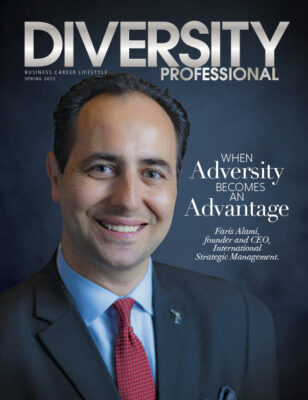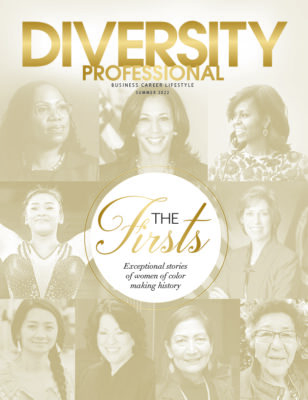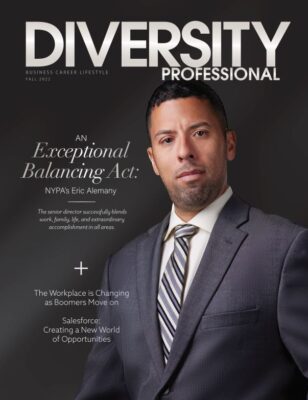GEM Writes Source Code For “2-D” Diversity In Tech Industry
In the wee small hours of the morning, in rural Lajas, Puerto Rico, a small town three hours from the capital, the daughter of social workers, Vanessa Aponte, is tossing in her sleep.
Her dreams of working for NASA are interrupted by scary thoughts of how much her Ph.D. will cost—more than $200,000.
She is gravely concerned her academic dream will turn into a debt nightmare. And there doesn’t seem to be a light at the end of tunnel: She has applied for a prestigious National GEM Consortium Fellowship, but the deadline has passed, and she has not heard back. She is rightfully thinking she likely did not receive the fellowship and will never be able to afford her Ph.D.
A ringing phone pierces the charcoal dawn. Her grandmother, a seamstress, hands her the brick-sized cell phone, with its 12-inch antenna.
“Mija, wake up. It’s for you. It’s GEM!” her grandmother says.
Hyperventilating, Aponte tries to catch her breath. Her heart plummets to her feet. GEM! She struggles to gain her footing, and her composure. Though racked with anxiety and discombobulated, she tries to stay calm as she turns on more lights and issues forward an apprehensive, “Hello, yes; this is Vanessa.”
It is the call she has been waiting for since she was a little girl flying kites and dreaming of one day soaring into space as a NASA astronaut.
“Good morning Vanessa. This is the executive director of GEM. We’d like to inform you that you’ve been awarded a full scholarship for your Ph.D. in aerospace engineering at the University of Colorado, and NASA will be sponsoring you.”

For economically disadvantaged students like Aponte seeking advanced STEM degrees, the National GEM Consortium is a dream come true—provided they meet GEM’s high academic standards, stringent criteria and rigorous application process.
Over the last 41 years, more than 1,500 candidates apply each year for GEM Fellowships to pursue master’s- and Ph.D.—level STEM disciplines. Out of that batch, about 600 make it to the final round and are judged eligible to receive a fellowship.
Yet the nonprofit can only award a little over 100 annually, leaving 500 very qualified candidates still searching for a way to make their STEM dreams come true.
“This is a major problem,” explains GEM’s Executive Director Brennon Marcano. “Because not only does GEM provide financial support, but it also places GEM fellows in internships with major tech companies like Intel and leading research institutions, such as NASA, which leads to the fellows gaining the critical work experience necessary to launch their STEM careers. But if we don’t have the funding, we can’t launch the next Ursula Burns (Xerox CEO) or hidden figure.”
Marcano is referring to the recent film about three black NASA scientists invaluable to successfully launching the first man into space.
Dr. Powtawche Williams Valerino is exactly the type of hidden figure Marcano is alluding to. A 1997 GEM fellow, Williams was the first Native American Ph.D. in mechanical engineering from Rice University.
“GEM fills the tech pipeline with highly qualified people of color, and has been doing so since its inception in 1976.”
Sitting in NASA’s Jet Propulsion Lab in Pasadena, California, Williams, now a senior scientist, reaches for a pen from her white lab coat, and draws a triangle, explaining the triangulation that occurred in her early 20s:
“GEM helped me realize my dream by providing financial support for my graduate degrees and summer work opportunities at NASA Johnson Space Center.”
Williams recalls, “If it wasn’t for GEM, I couldn’t have completed my doctoral degree in mechanical engineering—much less my Ph.D. There was just no way I could have afforded it! My research at Rice was related to the optimization of interplanetary trajectories to Mars via electric propulsion. And that research still serves as the basis for what I’m doing today.”
Marcano continues, “When you look at the GEM fellows since the organization was started, it’s a veritable STEM who’s-who list. A list that is not just limited to the Ursula Burns and Reginald Van Lees of the world, but also half of the female deans of engineering schools and some of their male counterparts, as well.”
“CEEK CEO, Mary Spio, owns more than 20 patents and has revolutionized two industries—and is now doing the same in the virtual reality industry. Georgia Tech’s Oscar Pena was awarded a groundbreaking patent in March. Nashlie Sephus and Ivan Walker founded a tech company that was recently purchased by Amazon.”
The highly regarded Oak Ridge National Lab award for outstanding individual accomplishment was won by GEM fellow Roderick Jackson. The list goes on and on. But what’s very troubling is that if you examine the abysmal U.S. STEM education rankings; the growing digital divide between people of color and whites; and the dearth of minorities in tech, you quickly realize that funding for GEM is needed more than ever, especially if the U.S. is going to be competitive in the global economy.”
“GEM fills the tech pipeline with highly qualified people of color, and has been doing so since its inception in 1976. This is a critical fact because numerous studies have proven that diverse and inclusive teams spur more innovation and revenue growth than teams that are not,” Marcano concludes.
Clearly: The Harvard Business Review (https://hbr.org/2013/12/how-diversity-can-drive-innovation) reported that a nationally representative survey of 1,800 professionals, 40 case studies and numerous focus groups and interviews showed that, “’2-D” diversity and comprehensive inclusion catapult a company’s performance, specifically in revenue and innovation:
“We scrutinized two kinds of diversity: inherent and acquired. Inherent diversity involves traits you are born with, such as gender, ethnicity and sexual orientation. Acquired diversity involves traits you gain from experience: Working in another country can help you appreciate cultural differences, for example, while selling to female consumers can give you gender smarts,” states Marcano.
“By correlating diversity in leadership with market outcomes as reported by respondents, we learned that companies with 2-D diversity out-innovate and out-perform others. Employees at these companies are 45 percent likelier to report that their firm’s market share grew over the previous year and 70 percent likelier to report that the firm captured a new market. 2-D diversity unlocks innovation by creating an environment where ‘outside the box’ ideas are heard.”
“When minorities form a critical mass and leaders value differences, all employees can find senior people to go to bat for compelling ideas and can persuade those in charge of budgets to deploy resources to develop those ideas.”
“There have been more than 4,000 GEM fellows since 1976,” Marcano notes. “To truly fill the pipeline, there should be more than 400,000.”
After graduation, more than 80 percent of GEM fellows are offered full-time jobs from sponsoring companies (such as MIT Lincoln Labs, Adobe and Aerospace).
GEM’s national network comprises corporations, government laboratories, universities and research institutions (www.gemfellowship.org/).
“GEM has a rich legacy and a vibrant future,” Marcano says with a proud smile. “On Sept.7, at our fundraising benefit gala in New York, we hope to raise more than $500,000 to continue that future—and to increase the number of GEM fellows this year to at least 500.”
Alumni like Vanessa Aponte hope that Marcano’s goal is not a dream deferred.









